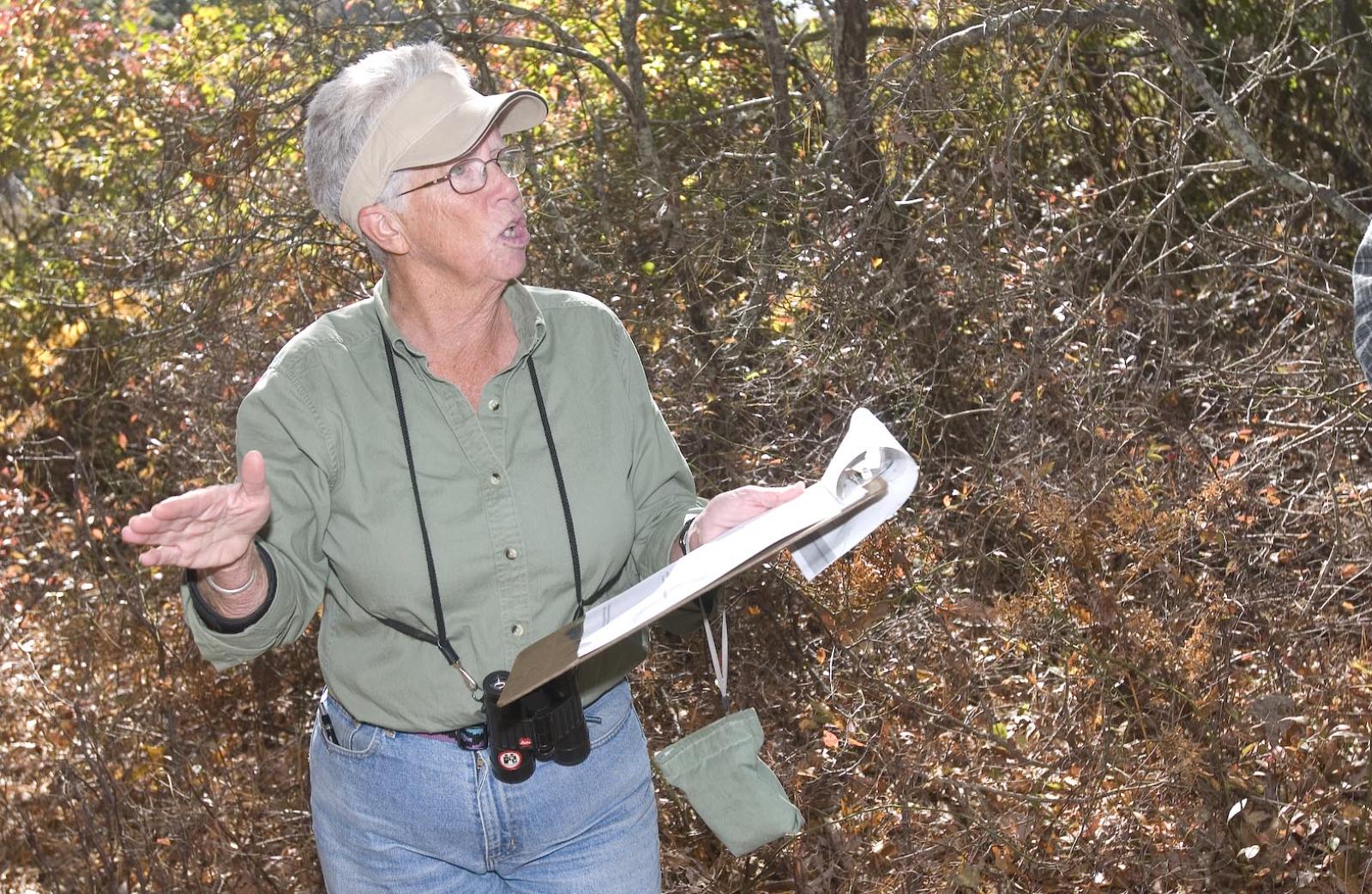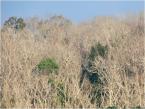Mysteries of Vineyard forests were revealed in a walk last Sunday afternoon at Felix Neck Wildlife Sanctuary. More than 10 naturalists took a walk with Beth Schwarzman, a Falmouth writer, geologist and savant who, like a detective, can read the hidden tales within ancient landscape.
Every forest has a tale, Ms. Schwarz-man said, though it may not be an obvious one. In this region, the natural progression of plants is towards forest — so whatever its previous use, land left alone becomes forest. What plants dominate that forest can offer clues to its past life.
She told those gathered at the Massachusetts Audubon Society sanctuary the story that today’s trees, shrubs and stone want to tell. As man has marked the landscape through the last three centuries, the work of colonists and old- time farmers can be understood. Stone foundations tell the story of a past buildings, stone walls mark the area of grazing sheep, the texture of soil along with trees and brush tell their own stories.
Sanctuary director Suzan Bellincampi reported at the start that the old property, like so many other places on the Island, was cleared for agricultural purpose. Most trees there are relatively young, and under the canopy of tall trees there is blueberry, ground cover and waist-thick brush.
Ms. Schwarzman described the landscape as a shifting sea of growing plants. They all are opportunistic. Some prefer bright sun, others live their lives in shade. A large oak that has a lot of horizontal branches reaching out in the forest is a pasture tree and may have begun its life in an open meadow. In its early life it was a shade tree, with little growing underneath.
A pasture tree doesn’t compete for sun like those tall narrow trees in a forest. Today that pasture tree may be living as a senior tree in a forest of tall young trees.
Oak trees that grow straight up and occupy a small area probably spent their whole life competing with other nearby trees for sun. All of their energy, then, is devoted to reaching high, competing for the most sun.
Ms. Schwarzman began the workshop giving those in attendance few clues to where they were walking. “We are going to take a walk. I want you to go out there and collect information,” she said. “Suspend disbelief,” she advised. Clipboards were passed around with a worksheet with simple questions: record the ground cover, record the shrub and vine layer, and record the trees.
In the first hour of the workshop they visited three sanctuary sites, the first a large grove of densely packed pitch pines and the second, a forest of tall oaks at the edge of a trail. The third spot they visited abutted the sanctuary visitor’s center and was overgrown with bittersweet and other mischievous vines. They walked past brambles with red, yellow and green leaves, the colors of autumn.
Back in a sanctuary classroom, students shared leaves, branches and notes they’d collected. Nature guides were spread out on the table, including a book Ms. Schwarzman wrote in 2002 called: The Nature of Cape Cod. So much of being a naturalist, she explained, is building on collected knowledge. “The more you know, the more you see when you are out in the field. The more you see in the field, the more you will know,” she said.
That cycle of learning creates naturalists. Paying attention offers a cumulative result, she said. Just starting to observe and note what you see is a good first step in understanding the story behind any land.
“Cape Cod and the Islands have a similar ecosystem,” she said. “Hopefully, what I know will help you illuminate your understanding of what is before you.”
For instance, she said Lobaria lichens on the side of trees is a wonderful sign of an ancient forest; trees grow slowly and so do these lichens. Pitch pines are pioneer trees that germinate preferentially on bare soil, formerly plowed land. Red cedar tree seeds are usually carried by birds that forage in short grass, so cedar trees often show up in abandoned grasslands.
So much of the land of Martha’s Vineyard had an agricultural use, old forests are not common. Large parcels of land were used for grazing sheep. The story gets hidden when a succession of plants steps in and takes over. In many places the land was plowed from year to year. When the plowing stopped, a natural progression of plants stepped in. Grassland was quickly replaced by brush and trees. Previously plowed land tends to have less canopy oak and more pine than unplowed sites.
Long after land has returned to woodlands, the plants in residence will share the story of what was before. Plowed land has no rocks on the top of the soil. A pile of rocks may mark the edge of a plowed field. The formerly open area may now have a mix of established alien invasive plants. A tall red cedar growing along with younger trees may also mark pasture land.
Woodlots were used for the growing and harvesting of trees. The signature of a woodlot is odd multiple trunks at the base of any standing tree; trees were routinely cut in woodlots, so the base of the tree was allowed to sprout a fresh new tree.
She talked about the harvesting of stones and what they tell. She displayed the necessary tools for splitting granite generations ago. In her hand she held a star drill. The drill metal was pounded into the rock to make a three-inch deep hole. After drilling a series of holes in a line, a stone mason inserted strips of metal called feathers, and then could break the rock using a wedge inserted between the two feathers. It was long and tedious work, but huge stones could be split with a series of slight taps of a hammer.
The afternoon walk included a surprise: Susie Bowman, the sanctuary teacher naturalist, was excited when she spotted a red admiral butterfly ahead on the trail. The insect hopped from one bough to another before disappearing. Mrs. Bowman said she didn’t expect to see this so late in the season.
Ms. Bellincampi said the walk is one of more adult programs that will be offered by the sanctuary. “We are looking at future programs that celebrate our cultural history — Felix Neck isn’t just a sanctuary, it has a rich cultural history with this community,” the director said.
On Friday, November 23, a day after Thanksgiving, Felix Neck will host their annual Fall Festival. This year’s theme is to share in that cultural history. Ms. Bellincampi said that for three generations the property was a farm owned and operated by the Smith family, and that story will be retold. For more information, call 508-627-4850.







Comments
Comment policy »